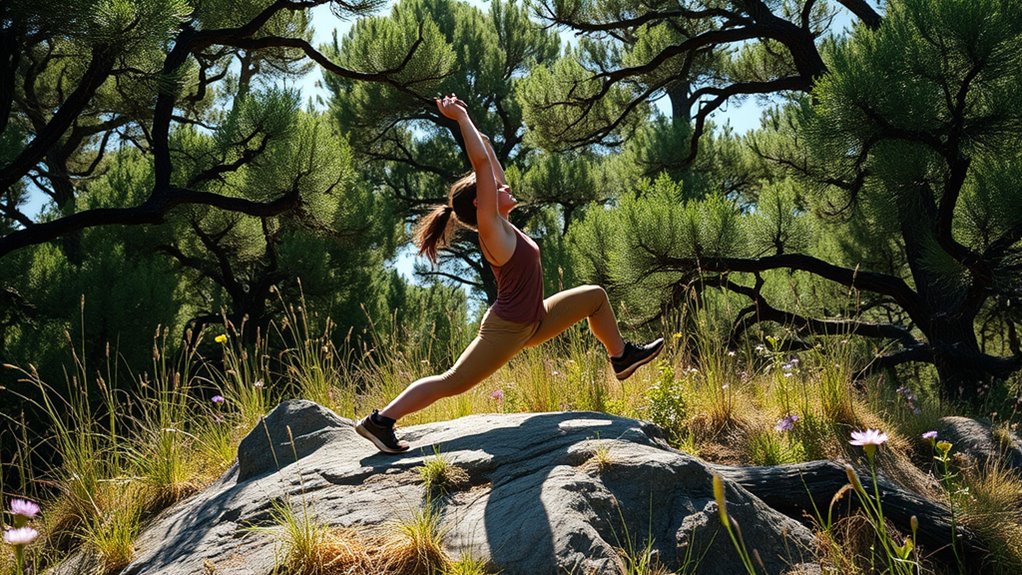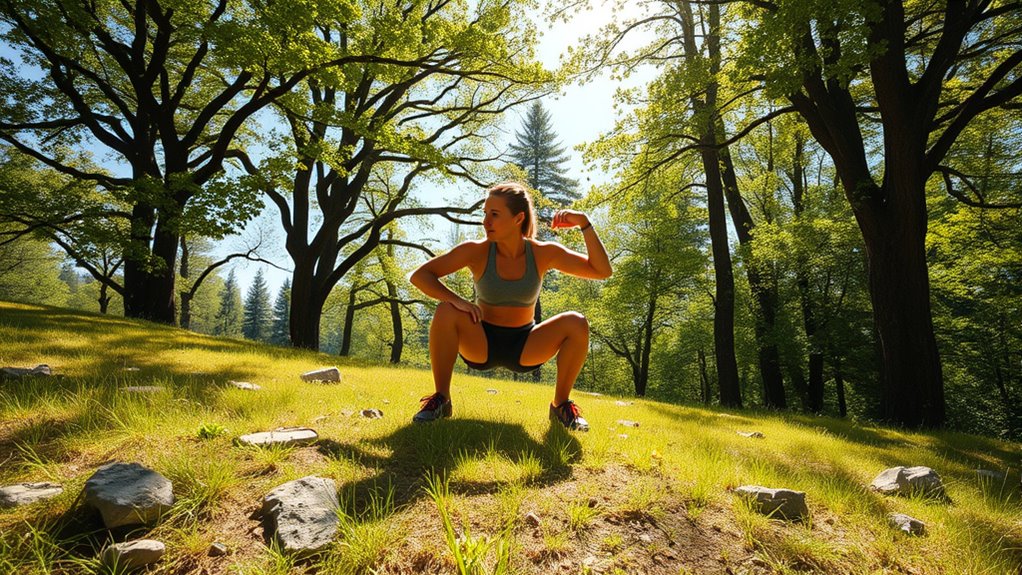To rewild your workout, connect with nature by incorporating outdoor movements like barefoot walking on uneven terrain, balancing on logs, climbing trees, or using park benches for alternatives to gym equipment. These primal movements activate muscles, boost coordination, and strengthen your body naturally. Exercising outdoors also lifts your mood and reduces stress. Embrace the environment as your gym, and discover how primal movement techniques can transform your strength and resilience as you explore further.
Key Takeaways
- Emphasize natural movements like crawling, jumping, and climbing to reconnect with primal body functions outdoors.
- Use environment elements such as logs, rocks, and benches as functional, equipment-free workout tools.
- Incorporate barefoot walking and uneven terrain to activate stabilizing muscles and improve balance.
- Engage in playful, spontaneous activities that promote mobility, strength, and mental well-being in natural settings.
- Focus on sustainable, enjoyable movement routines that foster a resilient, purpose-driven, and holistic fitness approach.

In today’s busy world, rewilding your workout means reconnecting with nature and embracing movement that feels instinctive and freeing. Instead of sticking to gym routines or machine workouts, you shift your focus to natural movement—those actions your body is inherently designed to perform. Outdoor fitness becomes your playground, allowing you to tap into the environment’s raw energy and enhance your strength naturally. When you rewild your workout, you’re not just exercising; you’re rediscovering how your body was meant to move.
Imagine walking barefoot on uneven terrain, feeling the earth beneath your feet. This simple act engages muscles that often stay dormant during traditional workouts. Balancing on rocks or logs challenges your stabilizers, improving coordination and core strength. Climbing trees or bushwhacking through shrubs mimics primal movements, activating muscles that may have been underused. These outdoor fitness activities encourage your body to move in ways it’s evolved to do—pushing, pulling, jumping, crawling—all rooted in natural movement.
Walking barefoot, balancing on natural surfaces, climbing trees—embrace primal movements to strengthen and connect with your body.
You’ll find that outdoor fitness doesn’t require fancy equipment or complex routines. Instead, it relies on your environment to provide resistance and variety. Use a sturdy branch for pull-ups, incorporate park benches for step-ups, or simply run on dirt trails instead of a treadmill. This approach not only boosts your strength but also enhances your agility and balance, making your body more adaptable in real-world situations. Plus, being outside exposes you to fresh air and sunlight, lifting your mood and helping your overall health.
Rewilding your workout also taps into the instinctive joy of movement. When you move freely and playfully, your body releases endorphins, reducing stress and increasing feelings of well-being. It’s about listening to your body’s natural signals, avoiding the rigidity of structured workouts, and embracing spontaneous, functional movements. You’ll notice improvements in your posture, flexibility, and resilience because these outdoor activities mimic everyday activities, making your body stronger for real-life challenges.
Ultimately, rewilding your workout is about reconnecting with your primal instincts and nature’s rhythms. It’s a reminder that fitness isn’t just about aesthetics or performance but about fostering a healthy, resilient body that moves with purpose and ease. Incorporating natural movement and outdoor fitness into your routine helps create a sustainable, enjoyable way to build strength—one that keeps you grounded, energized, and in tune with the world around you.
Frequently Asked Questions
Can Outdoor Exercises Replace Traditional Gym Workouts Completely?
You might think outdoor exercises can fully replace traditional gym workouts, but indoor alternatives offer unique benefits. The gym provides controlled environments and specialized equipment, while outdoor workouts boost natural strength and connect you with nature. Ultimately, the choice depends on your goals, preferences, and access. Combining both can give you a balanced approach, leveraging the strengths of gym vs outdoor to optimize your fitness journey.
What Safety Precautions Should I Take During Outdoor Rewilding Workouts?
When doing outdoor rewilding workouts, you should take safety precautions seriously. Wear insect repellent to avoid bites and check your surroundings for hazards. Dress appropriately for the weather, like layering in cold or rainy conditions. Stay aware of your environment, avoid uneven terrain to prevent falls, and carry water to stay hydrated. Taking these steps helps you enjoy the benefits of outdoor exercise safely and comfortably.
How Do I Start Rewilding if I Have Limited Outdoor Space?
Think of your limited outdoor space as a tiny jungle waiting to be explored. You can start rewilding with bodyweight exercises like push-ups, planks, or lunges on your apartment balcony or in your urban backyard. Use natural elements like benches, stairs, or trees to add variety. Even small spaces can become your wild playground, helping you develop strength while reconnecting with nature. Just get creative and seize every square inch!
Are There Specific Outdoor Activities Best for Beginner Strength Building?
If you’re new to outdoor strength building, focus on bodyweight basics like push-ups, squats, and planks on natural terrain. These activities require minimal equipment and are beginner-friendly. You can also incorporate simple movements like lunges or step-ups on uneven ground to challenge your muscles. Start slowly, listen to your body, and gradually increase intensity. Outdoor spaces provide a perfect setting to build strength naturally and enjoy the fresh air.
How Often Should I Incorporate Outdoor Workouts Into My Routine?
You should aim for outdoor workouts 3 to 4 times a week to build consistency. Frequency planning helps you stay motivated and guarantees steady progress. Incorporate a mix of activities like walking, bodyweight exercises, or hiking to keep things interesting. Consistent outdoor sessions boost your strength naturally and improve overall fitness. Listen to your body and adjust the frequency as needed, but maintaining regular outdoor activity is key to seeing results.
Conclusion
So, next time you hit the gym, remember that true strength was never meant to stay confined indoors. Rewilding your workout might just make you stronger, more adaptable, and maybe even a little wild. Ironically, the best way to tame your body’s potential is by embracing nature’s chaos. Who knew that the key to fitness was simply stepping outside and ignoring the treadmill? Sometimes, the wild side is exactly what your workout’s been missing.









